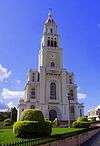People of the Dominican Republic
|
| |
| Total population | |
|---|---|
|
Dominican people 10,792,000[1] Total population of Dominican Republic | |
| Regions with significant populations | |
|
10,792,000[1] | |
| 1,757,961 | |
| 100,000 - 200,00[2][3][4][5] | |
| 63,096 | |
| 16,720[6] | |
| 11,399 | |
| 5,746 | |
| 5,661 | |
| 5,000 | |
| 3,299 | |
| 2,942[7] | |
| Languages | |
| Spanish | |
| Religion | |
|
Predominantly Roman Catholic; Protestant | |
| Related ethnic groups | |
| Africans · Afro-Caribbeans · Arabs · Amerindians · Canarians · Chinese · French · Germans · Italians · Jews · Latin Americans · Levantines · Portuguese · Spanish | |
Dominicans (Spanish: Dominicanos) are a multi-ethnic people who originate from the Dominican Republic. Dominican was historically the demonym for the inhabitants of the Captaincy General of Santo Domingo, and was retained after the nation's independence was obtained. The majority of Dominicans reside in the Dominican Republic, although there is also a large Dominican diaspora, mainly in the United States (also in Spain, Canada and Puerto Rico to a lesser extent). The population of the Dominican Republic in 2007 was estimated by the United Nations at 9,760,000.[8]
Name
For most of its history (up to independence) the colony was known as Santo Domingo, the name of its present capital, and its patron saint, Saint Dominic. Hence the residents were called "Dominicanos" (Dominicans), which is the adjective form of "Domingo", and the revolutionaries named their newly independent country "La República Dominicana". It was often referred to as the "Republic of San Domingo" in English language 19th Century publications.
Another name that's been commonly used is "Quisqueyanos". In the national anthem of the Dominican Republic (Himno Nacional) the author uses the poetic term Quisqueyanos, that is, "Quisqueyans" instead of Dominicans. The word "Quisqueya" is a derivative from a native tongue of the Taino Indians which means, "Mother of all Lands." It is often used in songs as another name for the country.
Genetics and ethnicities
The genetic makeup of the Dominican Republic's population is estimated to be 52.15% European, 39.57% Black African, and 8.28% Native American on average according to recent genealogical DNA testing.[9] African input is higher in the southeastern plain, and generally in coastal areas, while both the European and native components peak in the north-central region (Cibao).
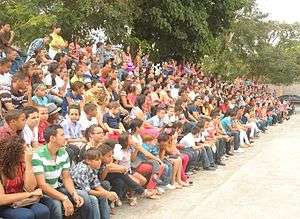
Most Dominicans fall within three major ethno-racial groups. The last census conducted in the country estimated the population as 73% mixed race (mainly of European and African descent), 16% White European (mainly of Spanish and French descent), and 11% Black African. Other groups in the country include the descendants of West Asians—mostly Lebanese, Syrians and Palestinians. A smaller, yet significant presence of East Asians (primarily ethnic Chinese and Japanese) can also be found throughout the population. Dominicans are also composed of Sephardic Jews that were exiled from Spain and the Mediterranean area in 1492 and 1497,[10] coupled with other migrations dating the 1700s[11] and during the second world war [12] contribute to Dominican ancestry.[13][14] Some of the Sephardic Jews still presently reside in Sosúa while others are dispersed throughout the country.[15] The amount of known Jews (or those with genetic proof of Jewish ancestry and/or practiced Jewish customs/religion throughout generations) are close to 3,000; the exact number of Dominicans with Jewish lineages aren't known, however, because of the inter-mixing of the Jews and Dominicans over a period of more than five centuries.
Immigration in the 20th and 21st centuries
In the twentieth century, many Chinese, Arabs (primarily from Lebanon and Syria), Japanese and to a lesser degree Koreans settled in the country, working as agricultural laborers and merchants. Waves of Chinese immigrants, the latter ones fleeing the Chinese Communist People's Liberation Army (PLA), arrived and worked in mines and building railroads. The current Chinese Dominican population totals 50,000.[16] The Arab community is also rising at an increasing rate.
In addition, there are descendants of immigrants who came from other Caribbean islands, including Saint Kitts and Nevis, Dominica, Antigua, St. Vincent, Montserrat, Tortola, St. Croix, St. Thomas, Martinique, and Guadeloupe. They worked on sugarcane plantations and docks and settled mainly in the cities of San Pedro de Macorís and Puerto Plata, they have a population of 28,000. There is an increasing number of Puerto Rican immigrants in and around Santo Domingo; they are believed to number at about 10,000. Before and during World War II 800 Jewish refugees moved to the Dominican Republic, and many of their descendants live in the town of Sosúa.[17] Nationwide, there are an estimated 100 Jews left.[18] Immigration from Europe and the United States is at an all-time high. 82,000 Americans (in 1999),[19] 40,000 Italians,[20] 1,900 French,[18] 1,400 Britons,[21] and 800 Germans.[18]
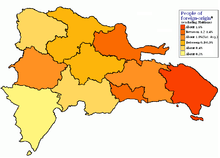
The 2010 Census registered 311,969 Haitians; 24,457 Americans; 6,691 Spaniards; 5,763 Puerto Ricans; and 5,132 Venezuelans.[22]
In the 2012, the Dominican government made a survey of immigrants in the country and found that there were: 458,233 Haitian-born; 13,514 U. S.-born (excluding Puerto Rican-born); 6,720 Spanish-born; 4,416 Puerto Rican-born; 4,044 Italian-born; 3,643 Chinese-born; 3,599 French-born; 3,434 Venezuelan-born; 3,145 Cuban-born; 2,738 Colombian-born; 1,792 German-born; among others.[23][24][25]
Emigration
United States
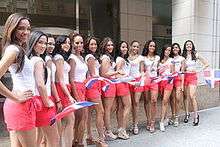
The first recorded person of Dominican descent to migrate to what is now known as the United States was sailor-turned-merchant Juan Rodriguez. He arrived on Manhattan in 1613 from his home in Santo Domingo, which makes him the first non-Native American person to spend substantial time in the island. He also became the first Dominican, the first Latino and the first person with European (specifically Portuguese) and African ancestry to settle in what is present day New York City.[26]
Dominican emigration to the United States continued throughout the centuries. Recent research from the CUNY Dominican Studies Institute has documented some 5,000 Dominican emigrants who were processed through Ellis Island between 1892 and 1924.[27]
During the second half of the twentieth century there were three significant waves of immigration to the United States. The first period began in 1961, when a coalition of high-ranking Dominicans, with assistance from the CIA, assassinated General Rafael Trujillo, the nation's military dictator.[28] In the wake of his death, fear of retaliation by Trujillo's allies, and political uncertainty in general, spurred migration from the island. In 1965, the United States began a military occupation of the Dominican Republic and eased travel restrictions, making it easier for Dominicans to obtain American visas.[29] From 1966 to 1978, the exodus continued, fueled by high unemployment and political repression. Communities established by the first wave of immigrants to the U.S. created a network that assisted subsequent arrivals. In the early 1980s, unemployment, inflation, and the rise in value of the dollar all contributed to the third and largest wave of emigration from the island nation, this time mostly from the lower-class. Today, emigration from the Dominican Republic remains high, facilitated by the social networks of now-established Dominican communities in the United States.[30]
Culture
The culture of the Dominican Republic, like its Caribbean neighbors, is a blend of the cultures of the European colonists, African slaves, and Taíno natives. Spanish, also known as Castellano (Castilian) is the official language. Other languages, among them English, French, German, Italian, and Chinese are also spoken to varying degrees. European, African and Taíno cultural elements are most prominent in food, family structure, religion and music. Many Arawak/Taíno names and words are used in daily conversation and for many foods native to the Dominican Republic.
Language
Spanish is the predominant language in the Dominican Republic; the local dialect is called Dominican Spanish, it closely resembles Canarian Spanish, and borrowed vocabularies from the Arawak language.[31] Schools are based on a Spanish educational model, with English and French being taught as secondary languages in both private and public schools. Haitian Creole is spoken by the population of Haitian descent. There is a community of about 8,000 speakers of Samaná English in the Samaná Peninsula. They are the descendants of formerly enslaved African Americans who arrived in the nineteenth century. Tourism, American pop culture, the influence of Dominican Americans, and the country's economic ties with the United States motivate other Dominicans to learn English.
Religion
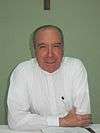
The Dominican Republic is 83% Christian, including 65% Roman Catholic and 18% Protestant. Recent but small scale immigration, as well as proselytizing, has brought other religions, with the following shares of the population: Spiritist: 1.2%,[32] The Church of Jesus Christ of Latter-day Saints: 1.1%,[33] Buddhist: 0.10%, Bahá'í: 0.1%,[32] Islam: 0.02%, Judaism: 0.01%, Chinese folk religion: 0.1%,.[32]
Roman Catholicism was introduced by Columbus and Spanish missionaries. Religion wasn't really the foundation of their entire society, as it was in other parts of the world at the time, and most of the population didn’t attend church on a regular basis. Nonetheless, most of the education in the country was based upon the Catholic religion, as the Bible was required in the curricula of all public schools. Children would use religious-based dialogue when greeting a relative or parent. For example: a child would say "Bless me, mother", and the mother would reply "May God bless you" {es}ven diga. The nation has two patroness saints: Nuestra Señora de la Altagracia (Our Lady Of High Grace) is the patroness of the Dominican people, and Nuestra Señora de las Mercedes (Our Lady Of Mercy) is the patroness of the Dominican Republic. The Catholic Church began to lose popularity in the late nineteenth century. This was due to a lack of funding, of priests, and of support programs. During the same time, the Protestant evangelical movement began to gain support. Religious tension between Catholics and Protestants in the country has been rare.
There has always been religious freedom throughout the entire country. Not until the 1950s were restrictions placed upon churches by Trujillo. Letters of protest were sent against the mass arrests of government adversaries. Trujillo began a campaign against the church and planned to arrest priests and bishops who preached against the government. This campaign ended before it was even put into place, with his assassination.
Judaism appeared in the Dominican Republic in the late 1930s. During World War II, a group of Jews escaping Nazi Germany fled to the Dominican Republic and founded the city of Sosúa. It has remained the center of the Jewish population since.[34]
Cuisine
Dominican cuisine is predominantly made up of a combination of Spanish and African influences over the last few centuries. The typical cuisine is quite similar to what can be found in other Latin American countries, but many of the names of dishes are different. One breakfast dish consists of eggs and mangú (mashed, boiled plantain). For heartier versions, these are accompanied by deep-fried meat (typically Dominican salami) and/or cheese. Similarly to Spain, lunch is generally the largest and most important meal of the day. Lunch usually consists of rice, some type of meat (chicken, beef, pork, or fish), beans, plantains, and a side portion of salad. "La Bandera" (literally, The Flag), the most popular lunch dish, consists of meat and red beans on white rice. There is a famous soup "Sancocho" a typical national soup made with seven kind of variety of meats.
Dominican cuisine usually accommodates all the food groups, incorporating meat or seafood; rice, potatoes, or plantains; and is accompanied by some other type of vegetable or salad. However, meals usually heavily favor starches and meats over dairy products and vegetables. Many dishes are made with sofrito, which is a mix of local herbs and spices sautéed to bring out all of the dish's flavors. Throughout the south-central coast, bulgur, or whole wheat, is a main ingredient in quipes or tipili (bulgur salad). Other favorite Dominican dishes include chicharrón, yuca, casabe, and pastelitos (empanadas), batata, pasteles en hoja, (ground-roots pockets)[35] chimichurris, plátanos maduros (ripe plantain), and tostones.
Some treats Dominicans enjoy are arroz con dulce (or arroz con leche), bizcocho dominicano (lit. Dominican cake), habichuelas con dulce (sweet creamed beans), flan, frío frío (snow cones), dulce de leche, and caña (sugarcane).
The beverages Dominicans enjoy include Morir Soñando, rum, beer, Mama Juana, batida (smoothie), jugos naturales (freshly squeezed fruit juices), mabí, and coffee.[36]
Music and dance
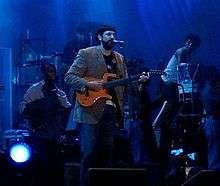
Musically, the Dominican Republic is known for the creation of the musical style called merengue,[37] a type of lively, fast-paced rhythm and dance music consisting of a tempo of about 120 to 160 beats per minute (it varies wildly) based on musical elements like drums, brass, and chorded instruments, as well as some elements unique to the music style of the DR. It includes the use of the tambora (Dominican drum), accordion, and güira. Its syncopated beats use Latin percussion, brass instruments, bass, and piano or keyboard. Between 1937 and 1950 the merengue music was promoted internationally, by some Dominicans groups like, Billo's Caracas Boys, Chapuseaux and Damiron Los Reyes del Merengue, Joseito Mateo and others. Later on it was more popularized via television, radio and international media, well-known merengue singers include singer/songwriter Juan Luis Guerra, Fernando Villalona, Eddy Herrera, Sergio Vargas, Toño Rosario, Johnny Ventura, and Milly Quezada and Chichí Peralta. Merengue became popular in the United States, mostly on the East Coast, during the 1980s and 90s,[38] when many Dominican artists, among them Victor Roque y La Gran Manzana, Henry Hierro, Zacarias Ferraira, Aventura, Milly, and Jocelyn Y Los Vecinos, residing in the U.S. (particularly New York City) started performing in the Latin club scene and gained radio airplay. The emergence of bachata, c along with an increase in the number of Dominicans living among other Latino groups in New York, New Jersey, and Florida have contributed to Dominican music's overall growth in popularity.[39]
Bachata, a form of music and dance that originated in the countryside and rural marginal neighborhoods of the Dominican Republic, has become quite popular in recent years. Its subjects are often romantic; especially prevalent are tales of heartbreak and sadness. In fact, the original name for the genre was amargue ("bitterness", or "bitter music", or blues music), until the rather ambiguous (and mood-neutral) term bachata became popular. Bachata grew out of, and is still closely related to, the pan-Latin American romantic style called bolero. Over time, it has been influenced by merengue and by a variety of Latin American guitar styles.
Salsa music has had a great deal of popularity in the country. During the late 1960s Dominican musicians like Johnny Pacheco, creator of the Fania All Stars, played a significant role in the development and popularization of the genre.
Particularly among the young, a genre that has been growing in popularity in recent years in the Dominican Republic is Dominican rap. Also known as Rap del Patio ("yard rap") it is rap music created by Dominican crews and solo artists. Originating in the early 2000s with crews such as Charles Family, successful rappers such as Lapiz Conciente, Vakero, Toxic Crow, and R-1 emerged. The youth have embraced the music, sometimes over merengue, merengue típico, bachata, as well as salsa, and, most recently, reggaeton. Dominican rap differs from reggaeton in the fact that Dominican rap does not use the traditional Dem Bow rhythm frequently used in reggaeton, instead using more hip hop-influenced beats. As well, Dominican rap focuses on urban themes such as money, women, and poverty, similarly to American rap.
Fashion
In only seven years, the Dominican Republic's fashion week has become the most important event of its kind in all of the Caribbean and one of the fastest growing fashion events in the entire Latin American fashion world. The country boasts one of the ten most important design schools in the region, La Escuela de Diseño de Altos de Chavón, which is making the country a key player in the world of fashion and design.
World famous fashion designer Oscar de la Renta was born in the Dominican Republic in 1932, and became a US citizen in 1971. He studied under the leading Spaniard designer Cristóbal Balenciaga and then worked with the house of Lanvin in Paris. Then by 1963, de la Renta had designs carrying his own label. After establishing himself in the US, de la Renta opened boutiques across the country. His work blends French and Spaniard fashion with American styles.[40][41] Although he settled in New York, de la Renta also marketed his work in Latin America, where it became very popular, and remained active in his native Dominican Republic, where his charitable activities and personal achievements earned him the Juan Pablo Duarte Order of Merit and the Order of Cristóbal Colón.[41]
Sports
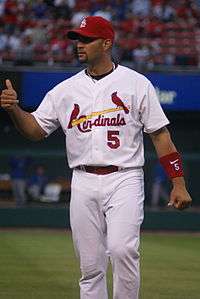
Baseball is by far the most popular sport in the Dominican Republic.[42] After the United States, the Dominican Republic has the second-highest number of Major League Baseball (MLB) players. Some of these players have been regarded among the best in the game. Historically, the Dominican Republic has been linked to MLB since Ozzie Virgil, Sr. became the first Dominican to play in the league. Among the outstanding MLB players born in the Dominican are: Manny Ramirez, David Ortiz, Vladimir Guerrero, Pedro Martínez, Albert Pujols, José Reyes, José Bautista, Hanley Ramírez, Miguel Tejada, Juan Marichal, Rafael Furcal and Sammy Sosa.
Olympic gold medalist and world champion over 400 m hurdles Félix Sánchez hails from the Dominican Republic, as does current defensive end for the San Diego Chargers (National Football League [NFL]), Luis Castillo. Castillo was the cover athlete for the Spanish language version of Madden NFL 08.[43]
The National Basketball Association (NBA) also has had players from the Dominican Republic, like Charlie Villanueva, Al Horford and Francisco García. Boxing is one of the more important sports after baseball, and the country has produced scores of world-class fighters and world champions.
Holidays
| Date | Name | |
|---|---|---|
| January 1 | New Year's Day | Non-working day. |
| January 6 | Catholic day of the Epiphany | Movable. |
| January 21 | Día de la Altagracia | Non-working day. Patroness Day (Catholic). |
| January 26 | Duarte's Day | Movable. Founding Father. |
| February 27 | Independence Day | Non-working day. National Day. |
| (Variable date) | Holy Week | Working days, except Good Friday. A Catholic holiday. |
| May 1 | International Workers' Day | Movable. |
| Last Sunday of May | Mother's Day | |
| (Variable date) | Catholic Corpus Christi | Non-working day. A Thursday in May or June (60 days after Easter Sunday). |
| August 16 | Restoration Day | Non-working day. |
| September 24 | Virgen de las Mercedes | Non-working day. A Patroness Day (Catholic) |
| November 6 | Constitution Day | Movable. |
| December 25 | Christmas | Non-working days. |
Notes:
- Non-working holidays are not moved to another day.
- If a movable holiday falls on Saturday, Sunday or Monday then it is not moved to another day. If it falls on Tuesday or Wednesday, the holiday is moved to the previous Monday. If it falls on Thursday or Friday, the holiday is moved to the next Monday.
Notable people
See also
- Dominican American
- Dominican-Puerto Rican
- List of Dominican Americans
- Dominicans in Spain
- Culture of the Dominican Republic
- Demographics of the Dominican Republic
- History of the Dominican Republic
Sources
- The Mulatto Republic: Class, Race, and Dominican National Identity. April J. Mayes. Gainesville: University Press of Florida, 2014. ISBN 978-0-8130-4919-9
References
- 1 2 Haiti & The Dominican Republic IMF population estimates
- ↑ http://www.elnuevodiario.com.do/mobile/article.aspx?id=359114
- ↑ http://www.diariolibre.com/economia/economia-personal/unos-40-mil-dominicanos-viven-en-situacin-difcil-en-espaa-JNDL369572
- ↑ INE 2009
- ↑ http://www.elnuevodiario.com.do/mobile/article.aspx?id=359114
- ↑ "Ethnic Origin (264), Single and Multiple Ethnic Origin Responses (3), Generation Status (4), Age Groups (10) and Sex (3) for the Population in Private Households of Canada, Provinces, Territories, Census Metropolitan Areas and Census Agglomerations, 2011 National Household Survey".
- ↑ |region11 =
 Chile |pop11 = 1,555 /bevoelkerung_nach_staatsangehoerigkeit_geburtsland/ STATISTIK AUSTRIA - Bevölkerung nach Staatsangehörigkeit und Geburtsland
Chile |pop11 = 1,555 /bevoelkerung_nach_staatsangehoerigkeit_geburtsland/ STATISTIK AUSTRIA - Bevölkerung nach Staatsangehörigkeit und Geburtsland - ↑ "World Population Prospects: The 2006 Revision, Highlights, Working Paper No. ESA/P/WP.202." (PDF). United Nations, Department of Economic and Social Affairs, Population Division. 2007. Retrieved 2008-01-13.
- ↑ Montinaro, Francesco; et al. (24 March 2015). "Unravelling the hidden ancestry of American admixed populations". Nature Communications. See Supplementary Data. doi:10.1038/ncomms7596. Retrieved 16 July 2015.
- ↑ "The Exile of the Jews due to the Spanish Inquisition". Retrieved 2013-05-15.
- ↑ "Jews migration in the 1700's". Retrieved 2013-05-15.
- ↑ "Jews migration to the Dominican Republic to seek refuge from the Holocaust". Retrieved 2013-05-15.
- ↑ "A partial, brief summary of Jews in the Dominican Republic". Retrieved 2013-05-15.
- ↑ "Dominican Republic-Jews". Retrieved 2013-05-15.
- ↑ "Municipal Map of the Dominican Republic showing the Historical Ancestry". Retrieved 2013-05-15.
- ↑ "The Chinese Community and Santo Domingo's Barrio Chino". Retrieved 2008-10-20.
- ↑ "CCNY Jewish Studies Class to Visit Dominican Village that Provided Refuge to European Jews During World War II". City College of New York. Retrieved 2007-05-22.
- 1 2 3 "Joshua Project People-in-Country Profile". Retrieved 2008-10-20.
- ↑ "American Citizens Living Abroad by Country" (PDF). Archived from the original (PDF) on October 19, 2008. Retrieved 2008-10-20.
- ↑ "* INFORM *; Giovani italiani nel Centro America e Caraibi". Retrieved 2008-10-20.
- ↑ "Special Reports: Brits Abroad". BBC News. 2006-12-06. Retrieved 2008-10-20.
- ↑ Oficina Nacional de Estadística (June 2012). "IX Censo Nacional de Población y Vivienda 2010: Volumen 1 (Informe General)" (PDF) (in Spanish). Santo Domingo. pp. 99–103. Archived from the original (PDF) on 2 December 2012. Retrieved 21 October 2014.
- ↑ Martínez, Darlenny (2 May 2013). "Estudio: en RD viven 534,632 extranjeros". El Caribe (in Spanish). Retrieved 29 May 2014.
Según la Primera Encuesta Nacional de Inmigrantes de la República Dominicana (ENI-2012), (...) Después de Haití, explica la investigación, las 10 naciones de donde proceden más inmigrantes son Estados Unidos, con 13,524; España, con 6,720, y Puerto Rico, con 4,416. Además Italia, con 4,040; China, con 3,643; Francia, con 3,599; Venezuela, con 3,434; Cuba con 3,145 inmigrantes; Colombia con 2,738 y Alemania con 1,792.
- ↑ ""Primera Encuesta Nacional de Inmigrantes (ENI-2012)" (in Spanish). Santo Domingo: Instituto Nacional de Estadística (former 'Oficina Nacional de Estadística') & United Nations Population Fund. p. 63. 2012.
- ↑ Juan Bolívar Díaz (4 May 2013). "RD país de emigrantes más que de inmigrantes" (in Spanish). Hoy. Retrieved 20 August 2014.
- ↑ Juan Rodriguez Archives | Voices of NY
- ↑ Preview of Research Findings October 22: Dominican Immigration Through Ellis Island - CUNY Dominican Studies Institute News
- ↑ "Justice Department Memo, 1975" (PDF). National Security Archive.
- ↑ International Migration in the Dominican Republic; Thomas K. Morrison, Richard Sinkin; International Migration Review, Vol. 16, No. 4, Special Issue: International Migration and Development (Winter, 1982), pp. 819-836; doi:10.2307/2546161
- ↑ Migration Trends in Six Latin American Countries
- ↑ Henríquez Ureña, Pedro (1940). El Español en Santo Domingo (in Spanish). Buenos Aires: Instituto de Filología de la Universidad de Buenos Aires.
- 1 2 3 "Religious Freedom Page". Retrieved 2009-02-27.
- ↑ "Country Profiles > Dominican Republic". Archived from the original on October 17, 2009.
- ↑ Haggerty, Richard (1989). "Dominican Republic - Religion". Dominican Republic: A Country Study. U.S. Library of Congress. Retrieved 2006-05-21.
- ↑ "Pasteles en hoja (Ground-roots pockets) - Dominican Cooking". Retrieved 2008-10-20.
- ↑ "Dominican Republic Cuisine by Hispaniola.com".
- ↑ Harvey, Sean (January 2006). The Rough Guide to The Dominican Republic. Rough Guides. pp. 376–7. ISBN 1-84353-497-5.
- ↑ The Rough Guide to The Dominican Republic. Rough Guides. January 2006. p. 375. ISBN 1-84353-497-5.
- ↑ The Rough Guide to The Dominican Republic Video on YouTube. Rough Guides. January 2006. p. 378. ISBN 1-84353-497-5. External link in
|title=(help) - ↑ Fashion: Oscar de la Renta (Dominican Republic) WCAX.com – Retrieved October 31, 2012.
- 1 2 Oscar de la Renta. Encyclopædia Britannica. Retrieved October 31, 2012.
- ↑ Harvey, Sean (January 2006). The Rough Guide to The Dominican Republic. Rough Guides. p. 59. ISBN 1-84353-497-5.
- ↑ Shanahan, Tom (2007-03-24). "San Diego Hall of Champions - Sports at Lunch, Luis Castillo and Felix Sanchez". San Diego Hall of Champions. Archived from the original on June 5, 2007. Retrieved 2007-05-29.
External links
- Consejo Nacional de Población y Familia (National Council of Population and Family) – The demographics department of the Dominican government

